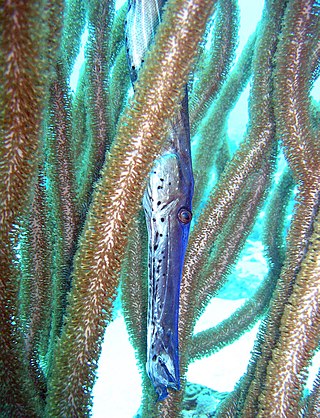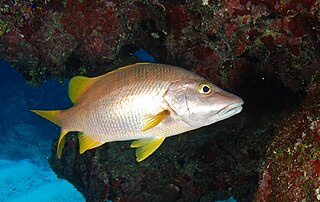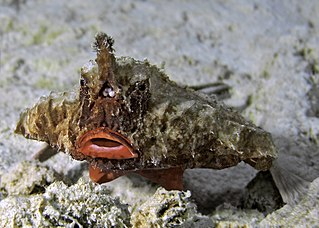
Aulostomus maculatus, the West Atlantic trumpetfish, is a long-bodied fish with an upturned mouth. It often swims vertically while trying to blend with vertical coral, such as sea rods, sea pens, and pipe sponges.

The red lionfish is a venomous coral reef fish in the family Scorpaenidae, order Scorpaeniformes. It is mainly native to the Indo-Pacific region, but has become an invasive species in the Caribbean Sea, as well as along the East Coast of the United States and East Mediterranean and also found in Brazil at Fernando de Noronha.

The lane snapper, the Mexican snapper, redtail snapper or spot snapper, is a species of marine ray-finned fish, a snapper belonging to the family Lutjanidae. It is native to the western Atlantic Ocean.

The yellow jack, also known as coolihoo, is a species of marine fish in the jack family, Carangidae. It is one of only two representatives of its genus present in the Atlantic Ocean, inhabiting waters off the east coast of the Americas from Massachusetts in the north to Brazil in the south, as well as a number of offshore islands. The yellow jack can be distinguished from closely related species by the length of the jaw, as well as counts of the rays in the fins. It is a fairly large fish, growing to a recorded maximum length of 1 metre (39 in), and a weight of at least 14 kilograms (31 lb). Yellow jack inhabit reefs, moving either individually or in schools and are predatory fish which primarily take other small fish. Studies in the Caribbean suggest the species reaches sexual maturity between 23 and 32 centimetres, and spawns in offshore waters from February to October. Yellow jack are of minor economic importance, taken by both hook and net methods, and are considered to be fair table fish. They are often caught by boat anglers, although are overlooked for their larger relatives.

The pink frogmouth, or redeye, pink gaper or uniform gaper, is a species of marine ray-finned fish belonging to the family Chaunacidae, the sea toads. This species is found in the Atlantic Ocean.

The schoolmaster snapper, is a species of marine ray-finned fish, a snapper belonging to the family Lutjanidae. It is found in the western Atlantic Ocean. Like other snapper species, it is a popular food fish.

The vermilion snapper, the clubhead snapper, night snapper or beeliner is a species of marine ray-finned fish, a snapper belonging to the family Lutjanidae. It is native to the western Atlantic Ocean.

Cephalopholis fulva, the coney or the butterfish, is a species of marine ray-finned fish, a grouper from the subfamily Epinephelinae which is in the family Serranidae which also includes the anthias and sea basses. It is found in the western Atlantic. It is associated with reefs and is a quarry species for commercial and recreational fisheries. It can be found in the aquarium trade.

Serranus tortugarum, the chalk bass, is a species of marine ray-finned fish, a sea bass from the subfamily Serraninae, classified as part of the family Serranidae which includes the groupers and anthias. It is found in the western Atlantic Ocean. This species is found in the aquarium trade.

Hypoplectrus unicolor, the butter hamlet or yellowtail hamlet, is a species of marine ray-finned fish, a sea bass from the subfamily Serraninae which is part of the family Serranidae, which also includes the groupers and anthias. It occurs in the western central Atlantic Ocean and occasionally makes its way into the aquarium trade.

Haemulon vittatum, the boga, is an ocean-going species of grunt native to the western Atlantic Ocean. Bogas are also known as the snit in Jamaica, and bonnetmouth in the Bahamas. It was first described by Cuban zoologist Felipe Poey. This species used to be classified as Inermia vittata, but genetic data revealed that it belongs to the genus Haemulon.

Bellator militaris, the horned sea robin, is a species of marine ray-finned fish belonging to the family Triglidae, the sea robins. This fish is found in the western Atlantic Ocean.

Liopropoma rubre, the peppermint bass or swissguard basslet, is a species of marine ray-finned fish, related to the groupers and classified within the subfamily Epinephelinae of the family Serranidae. It is found in the western Atlantic Ocean. This species is utilised in the aquarium trade.

The bluestriped grunt, also known as the boar grunt, golden grunt, humpback grunt, redmouth grunt, or yellow grunt, is a species of marine ray-finned fish, a grunt belonging to the family Haemulidae. It is found in the western Atlantic Ocean.

Ogcocephalus corniger, the longnose batfish, is a species of ray-finned fish belonging to the family Ogcocephalidae, the deep sea batfishes. This fish is found at depths between 29 and 230 m in the Atlantic Ocean, ranging from North Carolina to the Gulf of Mexico and the Bahamas. Like other members of the family Ogcocephalidae, it has a flat triangular body with coloring varying from yellowish to purple with pale, round spots. The lips are orange-red. Projecting from its head is a characteristic structure that is shared by other anglerfish.
Liopropoma carmabi, the candy basslet, is a species of fish in the family Serranidae.

The bigtooth cardinalfish or longtooth cardinalfish is a species of marine fish in the family Apogonidae and the only member of its genus. The bigtooth cardinalfish lives in the west-central Atlantic, off southern Florida, United States, and from the Bahamas to Venezuela, and as far south as Suriname. This species also is found in the east-central Atlantic and the Gulf of Guinea, and has been reported as far as Cape Verde. It is a pale orangeish colour.

Decodon puellaris, the red hogfish, is a species of marine ray-finned fish from the family Labridae, the wrasses, from the western Atlantic Ocean.

Kyphosus vaigiensis, the brassy chub, brassy drummer, long-finned drummer, low-finned drummer, Northern silver drummer, Queensland drummer, Southern drummer, blue-bronze sea chub, brassy rudderfish, yellow seachub, large-tailed drummer, low-finned chub or long-finned rudderfish, is a species of marine ray-finned fish, a sea chub from the family Kyphosidae. It is a largely herbivorous species which has a circumglobal distribution. Studies in the 21st Century appear to have shown that some other species in the genus Kyphosus are junior synonyms of this taxon.

The silk snapper, the West Indian snapper, yellow-eyed snapper or yellow-eyed red snapper, is a species of marine ray-finned fish, a snapper belonging to the family Lutjanidae. It is found in the Western Atlantic Ocean.




















